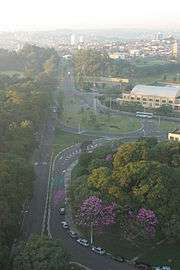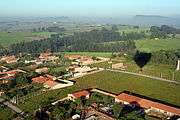Piracicaba
Piracicaba (Portuguese pronunciation: [piɾɐsiˈkabɐ] or [piˌɾasiˈkabɐ]) is a city located in the Brazilian state of São Paulo. The population is 404,142 (2019) in an area of 1378.07 km².[1] It is at an elevation of 547 m above sea level.
Piracicaba | |
|---|---|
.jpg) | |
 Flag  Coat of arms | |
 Location in São Paulo state | |
 Piracicaba Location in Brazil | |
| Coordinates: 22°43′31″S 47°38′57″W | |
| Country | Brazil |
| Region | Southeast |
| State | São Paulo |
| Government | |
| • Mayor | Barjas Negri (PSDB) |
| Area | |
| • Total | 1,378.07 km2 (532.08 sq mi) |
| Elevation | 547 m (1,795 ft) |
| Population (2019) | |
| • Total | 404,142 |
| • Density | 290/km2 (760/sq mi) |
| Time zone | UTC-03:00 (BRT) |
| • Summer (DST) | UTC-02:00 (BRST) |
| Postal code | 13400-000 |
| Website | www |
Name
The place name comes from a word in the Tupi language that means "place where the fish stops".[2] The name arises from the fact that the waterfalls of the Piracicaba River, which bisects the city, is a point at which "piracema"—fish swimming upstream to reproduce.[3] Larger fish species such as the dourados can still be observed.[4][5]
History
In 1766, Antonio Correa Barbosa, charged with the task of establishing a settlement on the estuary of Piracicaba river, opted for a location about 90 km from it.[6] The settlement was officially founded on August 1, 1767, as a povoação subordinated to the vila of Itu.[2] In 1784, Piracicaba gets emancipated from Itu, becoming a freguesia.[2]
In 1821, the freguesia is promoted to vila, known as Vila Nova da Constituição. In 1856, Vila Nova da Constituição is promoted to city status and in 1877 it is officially named "Piracicaba", following a law by the then councilman and future Brazilian president Prudente de Morais.[2]
In 1944, the city was made the seat of the Roman Catholic Diocese of Piracicaba.[7]
Notable institutions, events, resources
Piracicaba is home to the oldest agricultural university in Brazil, the Luiz de Queiroz School of Agriculture of the University of São Paulo.[8] Founded in 1901, the school is located on a farm with a large collection of trees and plants. It is also recognized as a leader in the field of precision agriculture. Other universities based in Piracicaba are the Methodist University of Piracicaba (UNIMEP)[9] and the University of Campinas' School of Dentistry.[10]
Piracicaba is known by the nickname "Noiva da Colina" (bride of the hills),[11] and is the annual host to the "Festa das Nações" (Nations' Party, where people may find foods from all over the world),[12] and to the "Salão Internacional do Humor" (International Humor Exhibition), where cartoonists from around the world display comic drawings.[13][14]
Economy


Piracicaba is famous for sugarcane plantations,[15] traditional cachaça production, and traditional music.
In particular, its economy, as of this year, is fueled by the cultivation of sugarcane. The harvest of sugarcane produces many products, including sugar, oil, and ethanol.[16] Copersucar, a large company that has a center of research on genetic improvement of sugarcane participates in this growing industry.
Another characteristic economic feature is the presence of large industries, where the main ones are Caterpillar,[17] ArcelorMittal,[18] and Hyundai.[19]

Geography
Piracicaba's altitude is 554 meters.[20] Temperatures through the year vary from 37.5° Celsius maximum to 16.0° Celsius minimum, and Piracicaba experiences annual rainfall of 123 centimeters. The area of the city is 1,378 square kilometers, making it the 19th largest city in the State of São Paulo. The urban area of Piracicaba is approximately 158 square kilometers, and 95% of the population resides in it.
Demographics
The population in 2019 was 404,142. The Human Development Index for the city was 0.710 in 2000, and 0.785 in 2010, both falling in the "high" category.[21]
Utilities
As of 2010, water and power are supplied at a level approaching 100% of the households.[22] As of 2013 there were approximately 164 telephones, and 333 cars, both statistics per thousand people.
Religion
Like the cultural variety in Piracicaba, there are several religious manifestations in the city. It is possible to find in the city dozens of different Protestant denominations, as well as the practice of Buddhism, Islamism, Spiritism, and others. In the last decades, Buddhism and Eastern religions have grown in the city. There also are the Jewish, Mormon and Afro-Brazilian religions. According to data from the 2019 Census conducted by the IBGE, the population of Piracicaba was composed that year by Catholics (59.78%), Evangelicals (27.42%), no religious affiliation (7.47%), Spiritist (2.9%) and Jehovah's Witnesses (0.95%). The remaining 2.09% of the resident population declared themselves of other denominations or of undetermined religion.
Source: IBGE - Census 2019
Notable natives
- José Altafini, also known as "Mazola", a Brazilian footballer.
- Jonathan Cafú, footballer
- André Cypriano, documentary photographer
- Evaristo Conrado Engelberg, engineer and inventor
- Ronaldo Guiaro, footballer
- Marcos Pizzelli-Brazilian footballer.
- Rubens Ometto Silveira Mello, owner of Cosan.
Sister cities

References
- "IBGE - Instituto Brasileiro de Geografia e Estat韘tica". ibge.gov.br. Retrieved 4 March 2016.
- "IBGE | Cidades | São Paulo | Piracicaba | Histórico". cidades.ibge.gov.br. Retrieved 2016-03-04.
- "Piracema começa, pesca fica proibida e fiscalização aumenta em Piracicaba" (in Portuguese). 2015-10-31. Retrieved 2016-10-05.
- "Terra da Gente mostra que o rio Piracicaba está para peixe grande". Terra da Gente (in Portuguese). 2015-06-11. Retrieved 2019-04-20.
- "Piracicaba, seu rio, seus peixes". Issuu. Retrieved 2019-04-20.
- Tecnologia, Imagenet. "Prefeitura do Município de Piracicaba". www.urbal.piracicaba.sp.gov.br (in Breton). Retrieved 2016-03-04.
- Piracicaba, Diocese de. "Criação da Diocese | Diocese de Piracicaba". www.diocesedepiracicaba.org.br. Retrieved 2016-04-04.
- "Who we are | University of São Paulo". www.en.esalq.usp.br. Retrieved 2016-03-04.
- "UNIMEP".
- "Portal FOP-Unicamp". www.fop.unicamp.br. Retrieved 2016-10-05.
- "A "Noiva da Colina" e o véu — A Província - Paixão por Piracicaba". A Província - Paixão por Piracicaba (in Portuguese). Retrieved 2016-03-04.
- "Festa das Naçoes de Piracicaba:33 anos de história".
- "EBC". memoria.ebc.com.br. Retrieved 2016-03-04.
- "Salão Internacional de Humor de Piracicaba | História". salaointernacionaldehumor.com.br. Retrieved 2016-03-04.
- Audi, Raul. "A study on sugarcane cultures in the Piracicaba region by means of photointerpretation: Part II". Bragantia. 27 (2): 383–394. doi:10.1590/S0006-87051968000200013. ISSN 0006-8705.
- Moraes, Márcia Azanha Ferraz Dias de; Zilberman, David (2014-03-31). Production of Ethanol from Sugarcane in Brazil: From State Intervention to a Free Market. Springer Science & Business Media. p. 87. ISBN 9783319031408.
- "A Caterpillar no Brasil". MEMORIAL DO EMPREENDEDORISMO. Retrieved 2016-03-04.
- "Câmara homenageia Belgo - Grupo Arcelor Mittal". www.camarapiracicaba.sp.gov.br (in Portuguese). Retrieved 2016-10-05.
- AW Staff (2011-02-28). "Brazil: Hyundai breaks ground on Piracicaba plant". automotiveworld.com. Retrieved 4 March 2016.
[Quoting:] Hyundai has launched construction on its Piracicaba plant in Brazil’s Sao Paulo state. The new 150,000upa plant is Hyundai’s seventh outside of South Korea. The manufacturer is investing US$600m in the Piracicaba facility, which will start production in the second half of 2012...
- "LOCALIZAÇÃO, RELEVO E EXTENSÃO TERRITORIAL DE PIRACICABA" (PDF). IPPLAP. Retrieved April 4, 2016.
- "IBGE | Cidades | São Paulo | Piracicaba". www.cidades.ibge.gov.br. Retrieved 2019-08-29.
- "NÍVEL DE ATENDIMENTO DE ABASTECIMENTO DE ÁGUA NO MUNICÍPIO DE PIRACICABA - 1991, 2000 E 2010" (PDF). IPPLAP- Instituto de Pesquisas e Planejamento de Piracicaba. Retrieved October 4, 2016.